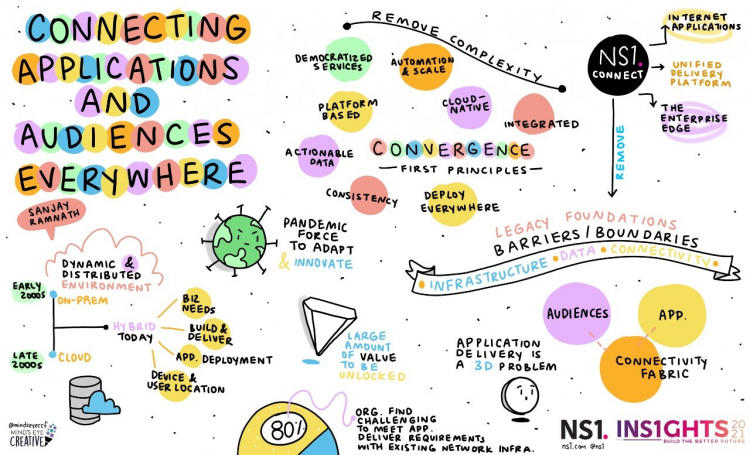In part one of this blog series - Your Business Depends on Eliminating Boundaries Between Applications, Users, Infrastructure, and Data - we covered how businesses are falling short in unlocking the full value from digital transformation with the traditional approach.
In this post, we’ll discuss the principles we’ve developed at NS1 to unlock this full value, as well as how we put them into practice with NS1 Connect.
Keep reading for key takeaways, or view our VP Product Sanjay Ramnath’s full INS1GHTS session for a deeper dive.
Watch the Full Replay of this Session from INS1GHTS2021: Build the Better Future
Catch the full replay, as well as all the other great sessions from INS1GHTS2021, at our replay hub.
NS1 Principles to Eliminating Boundaries in Your Foundational Infrastructure
So how do we build foundational infrastructure that addresses these challenges? We identified the following as key principles:
First, we need a platform-based approach to bring consistency, uniformity, and convergence of core network services.
We need cloud-native operations. To provide services everywhere or anywhere they’re needed, we need to deliver in a lightweight, software-based approach. To establish consistency across heterogeneous environments, we need consistent API frameworks, automation, and simple, intelligent traffic management.
And then last but not the least, our platform must be integration-friendly. This ensures that we can consume data within the ecosystem, share learnings, and strengthen infrastructure as a result.

The Synthesis of These Principles is NS1 Connect
We synthesized these principles in NS1 Connect - our unified delivery platform for all our services, including: cloud-native network services, edge-to-cloud networking solutions, and application traffic optimization solutions. So how does NS1 Connect eliminate the boundaries we identified in Part One?
On the infrastructure side, our control plane is centrally provided and centrally consumable as a cloud solution. Our products can be deployed wherever they're needed, in a lightweight fashion. We are aligned with cloud-native operations and provide platform-agnostic products. We're programmable and extensible through APIs.
When it comes to removing data boundaries, NS1 Connect makes data actionable by integrating with internet data sources, infrastructure data sources, and community data sources. It also provides the right workflows, the right control, and visibility and policy workflows over that data.
And then finally, it removes connectivity boundaries. It provides global-scale infrastructure across all our services. Doesn't matter if it's a DNS service or a DotP DNS or IPAM service for the enterprise network, or application traffic management. It's all done at a highly scalable and global fashion.
More specifically, NS1 Connect achieves this by:
Simplifying management of all your solutions with a centralized, cloud portal featuring a consistent user experience across every solution
Having a consistent, high-performance, comprehensive API framework.
Pulling in some common network services into the platform. For example, IP address management (IPAM) can be centralized across your entire network.
Extracting actionable insights from all your different analytics, reporting, observability, and visibility tools, and presenting these learnings in a consumable way.
And then, we deliver services over the platform, both our external services, our internet-facing application services and also, our enterprise services. Things that we can provide to connect enterprise users and devices. And they all share this common set of first principles, delivered over NS1 Connect.
Ultimately, this is about removing complexity. Convergence, to some extent, helps move away from that fragmented ecosystem of solutions. Instead, you’re able to solve common problems in a more uniform way, such as: managing network resources across your entire network footprint, automating workflows, managing resources for external and internal applications, and so on. Using NS1 Connect as a delivery model allows us to quickly address the needs as we engage deeper within the application and access networking ecosystem.